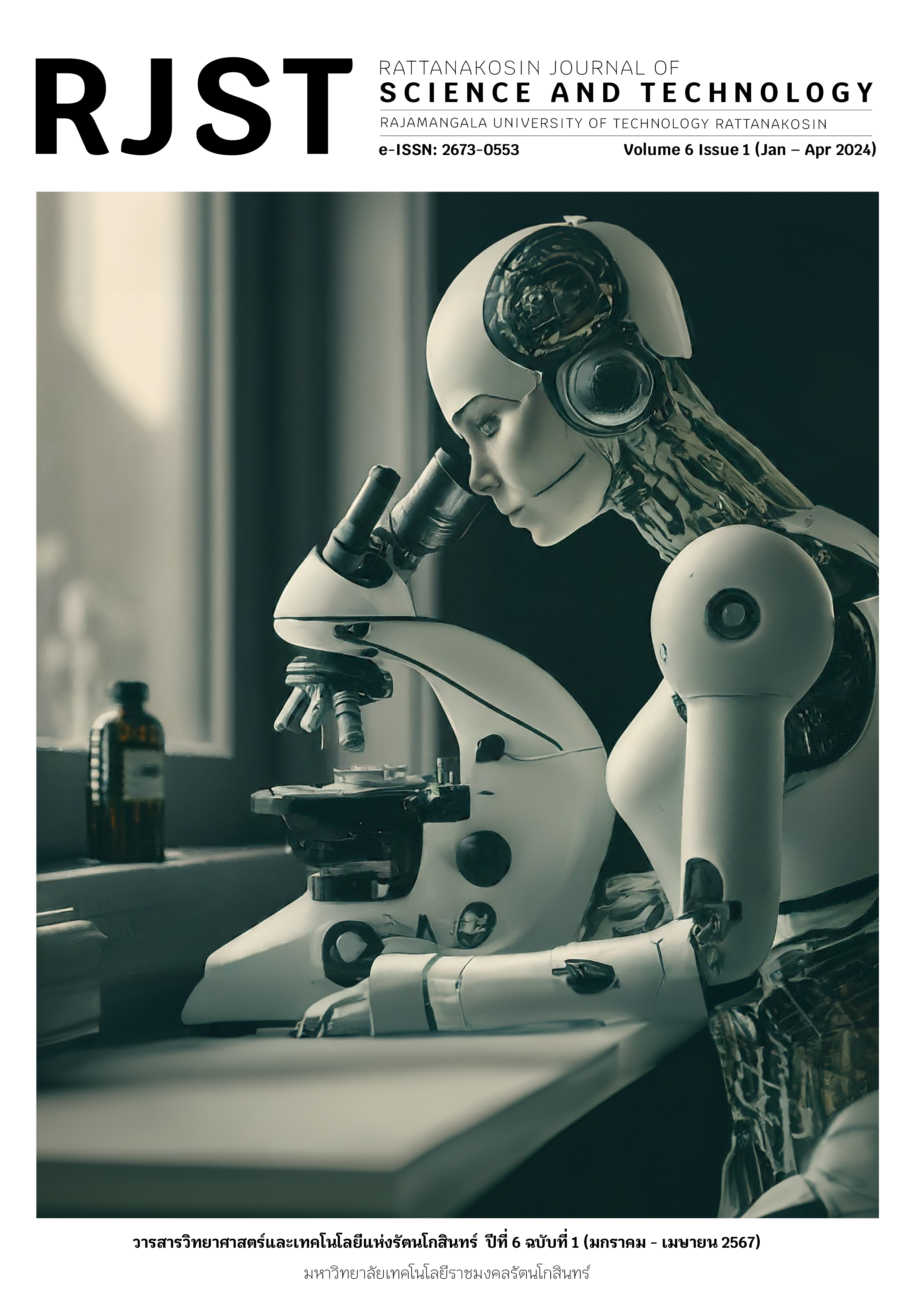ผลของสีและคุณค่าทางโภชนาการของผลิตภัณฑ์บิสกิตที่มีการทดแทน แป้งสาลีด้วยแป้งหัวปลี
Main Article Content
บทคัดย่อ
งานวิจัยนี้มีวัตถุประสงค์เพื่อศึกษาสารละลาย 3 ชนิด (น้ำซาวข้าว สารละลายน้ำผึ้ง สารละลายกรดซิตริกร้อยละ 2) โดยใช้น้ำกลั่นเป็นตัวควบคุม ต่อการยับยั้งปฏิกิริยาสีน้ำตาลของหัวปลี จากนั้นนำแป้งหัวปลีไปใช้ทดแทนแป้งสาลีในผลิตภัณฑ์บิสกิต วิเคราะห์ลักษณะทางกายภาพด้านสี (L* a* b*) ของแป้งหัวลี และวิเคราะห์คุณค่าทางโภชนาการ (ไขมัน โปรตีน ใยอาหาร) ของบิสกิต ผลการทดลองพบว่า นํ้าซาวข้าวสามารถยับยั้งการเกิดปฏิกิริยาสีนํ้าตาลได้ดีที่สุด โดยพบว่ามีค่าความสว่าง (L*) ค่าความเป็นสีแดง (a*) และค่าความเป็นสีเหลือง (b*) ที่ดีกว่าสารละลายทั้ง 2 ชนิด นอกจากนี้บิสกิตเสริมแป้งหัวปลีที่ร้อยละ 0, 25, 50, 75 และ100 มีค่าความสว่าง (L*) เท่ากับ 70.40, 27.36, 26.60, 29.19, 28,92 ค่าความเป็นสีแดง (a*) เท่ากับ 3.34, 6.40, 5.84, 6.06, 6.64 และ ค่าความเป็นสีเหลือง (b*) เท่ากับ 27.94, 10.55, 10.50, 12.69, 15.12 ตามลำดับ บิสกิตมีเสริมแป้งหัวปลีร้อยละ 25 มีค่าโปรตีน ไขมัน ใยอาหาร เท่ากับร้อยละ 1.38, 22.65, 62.05 ในขณะที่บิสกิตสูตรควบคุม เท่ากับร้อยละ 0.59, 20.47, 15.48 ตามลำดับ โดยมีความแตกต่างอย่างมีนัยสำคัญทางสถิติ (p≤0.05)
Article Details

This work is licensed under a Creative Commons Attribution-NonCommercial-NoDerivatives 4.0 International License.
ข้อความภายในบทความที่ตีพิมพ์ในวารสารทั้งหมด รวมถึงรูปภาพประกอบ ตาราง เป็นลิขสิทธิ์ของมหาวิทยาลัยเทคโนโลยีราชมงคลรัตนโกสินทร์ การนำเนื้อหา ข้อความหรือข้อคิดเห็น รูปภาพ ตาราง ของบทความไปจัดพิมพ์เผยแพร่ในรูปแบบต่าง ๆ เพื่อใช้ประโยชน์ในเชิงพาณิชย์ ต้องได้รับอนุญาตจากกองบรรณาธิการวารสารอย่างเป็นลายลักษณ์อักษร
มหาวิทยาลัยฯ อนุญาตให้สามารถนำไฟล์บทความไปใช้ประโยชน์และเผยแพร่ต่อได้ โดยต้องแสดงที่มาจากวารสารและไม่ใช้เพื่อการค้า
ข้อความที่ปรากฏในบทความในวารสารเป็นความคิดเห็นส่วนตัวของผู้เขียนแต่ละท่านไม่เกี่ยวข้องกับราชวิทยาลัยจุฬาภรณ์ และบุคลากร คณาจารย์ท่านอื่น ๆ ในมหาวิทยาลัยฯแต่อย่างใด ความรับผิดชอบองค์ประกอบทั้งหมดของบทความแต่ละเรื่องเป็นของผู้เขียนแต่ละท่าน หากมีความผิดพลาดใด ๆ ผู้เขียนแต่ละท่านจะรับผิดชอบบทความของตนเอง ตลอดจนความรับผิดชอบด้านเนื้อหาและการตรวจร่างบทความเป็นของผู้เขียน ไม่เกี่ยวข้องกับกองบรรณาธิการ
References
Kant, A., & Graubard, B. (2015). 40-year trends in meal and snack eating behaviors of American adults. Journal of the Academy of Nutrition and Dietetics. 115(1), 50-63.
Bellisle, F. (2014). Meals and snacking, diet quality and energy balance. Physiology & Behavior, 134, 38-43.
Larson, N. I., Miller, J. M., Watts, A. W., Story, M. T., & Neumark-Sztainer, D. R. (2016). Adolescent Snacking Behaviors Are Associated with Dietary Intake and Weight Status. The Journal of Nutrition. 146(7), 1348-1355.
Mattes, R. D. (2018). Snacking: A cause for concern. Physiology & Behavior. 193, 279–283.
Anton, A. A., Fulcher, R. G., & Arntfield, S. D. (2009). Physical and nutritional impact of fortification of corn starch-based extruded snacks with common bean (Phaseolus vulgaris L.) flour: Effects of bean addition and extrusion cooking. Food Chemistry. 113(4), 989-996.
Bailey, R. A., Clark, H. M., Ferris, J. P., Krause, S., & Strong, R. L. (2002). Solid waste disposal and recycling. Chemistry of the Environment.
Sharmila, & Puraikalan2, Y. D. (2013). Development and Evaluation of Banana Blossom Incorporated Dark Chocolate. International Journal of Science and Research, 4(4), 1409-1411.
Evaveniya, E. & Jayamuthunagai, J. (2014). Functional, Physicochemical and Anti-oxidant properties of Dehydrated Banana Blossom Ppwder and its Incorporation in Biscuits. International Journal of ChemTech Research CODEN. 6(9), 4446-4454.
Tasnim, T., Das, P. C., Begum, A. A., Nupur, A. H., & Mazumdera A. R. (2020). Nutritional, textural and sensory quality of plain cake enriched with rice rinsed water treated banana blossom flour. Journal of Agriculture and Food Research. 100071, 1-3.
Khatun, M., Wadud Ahmed, Md., Mosharraf Hossain, Md., Karmoker, P., & Iqbal, A. (2021). Utilization of Banana Peel Flour in Biscuit Making as Wheat Flour Substitute. European Journal of Agriculture and Food Sciences. 3(6), 32-35.
AOAC, 2005 AOAC Official methods of analysis (17th ed.) (2005). Association of Official Analytical Chemistry, Washington, DC.
ฤทัยภักดิ์ ชาญศรี และเนาวรัตน์ กองคำ. (2565). การยับยั้งปฏิกิริยาการเกิดสีน้ำตาลด้วยสารสกัดรำข้าวหอมมะลิสุรินทร์ (กข 15) ในผลมะเขือยาวสไลด์สด. วารสารวิทยาศาสตร์และเทคโนโลยีหัวเฉียวเฉลิมพระเกียรติ. ปีที่ 8 ฉบับที่ 1 มกราคม - มิถุนายน 2565.
Lattanzio, V., Linsalata, V., Palmieri, S., & Sumere, C. F. V. (1989). The beneficial effect of citric and ascorbic acid on the phenolic browning reaction in stored artichoke (Cynara scolymus L.) heads. Food Chemistry. 33(2), 93-10.
Alshehry, G. A. (2022). Medicinal Applications of Banana Peel Flour Used as a Substitute for Computing Dietary Fiber for Wheat Flour in the Biscuit Industry. Hindawi Applied Bionics and Biomechanics. 2-4.

